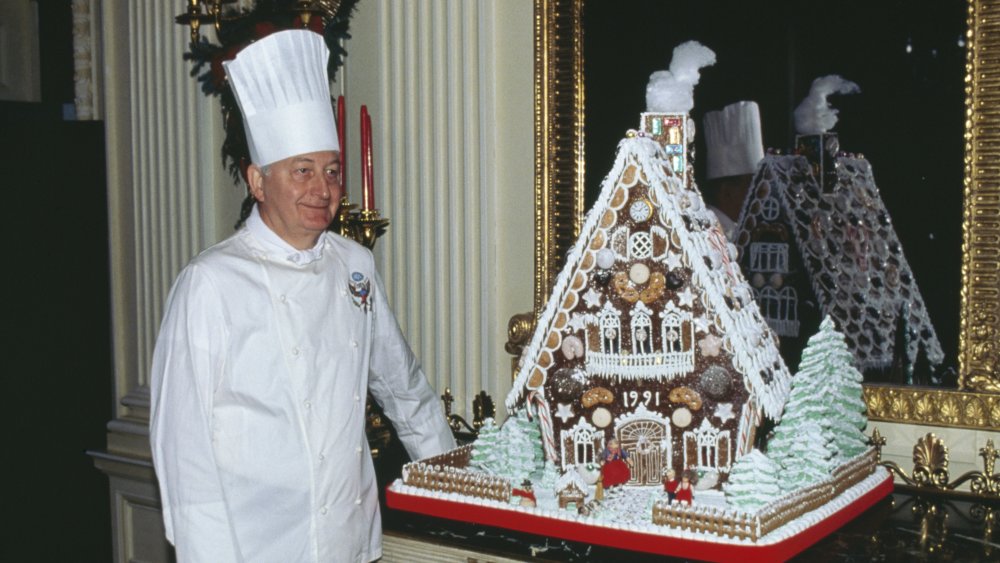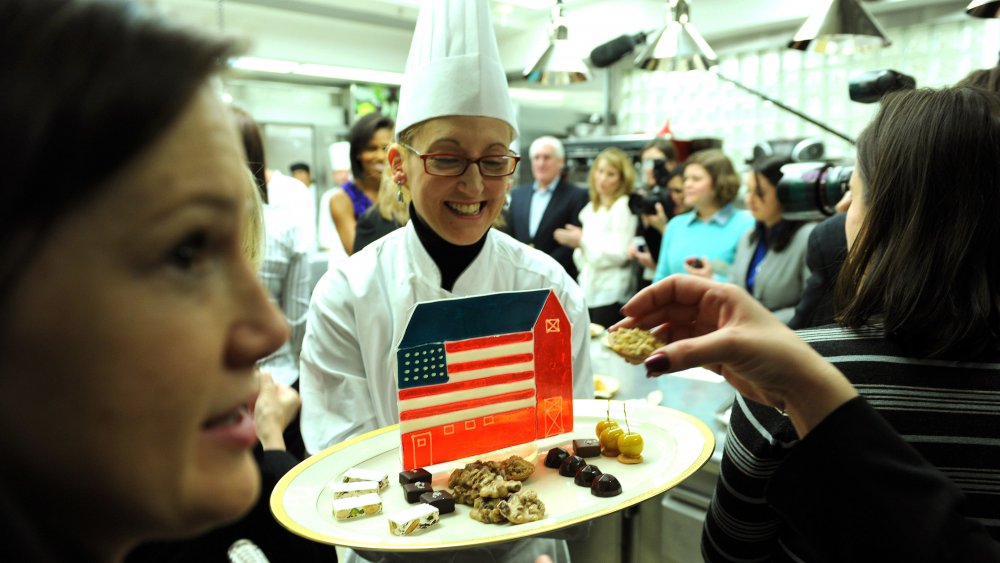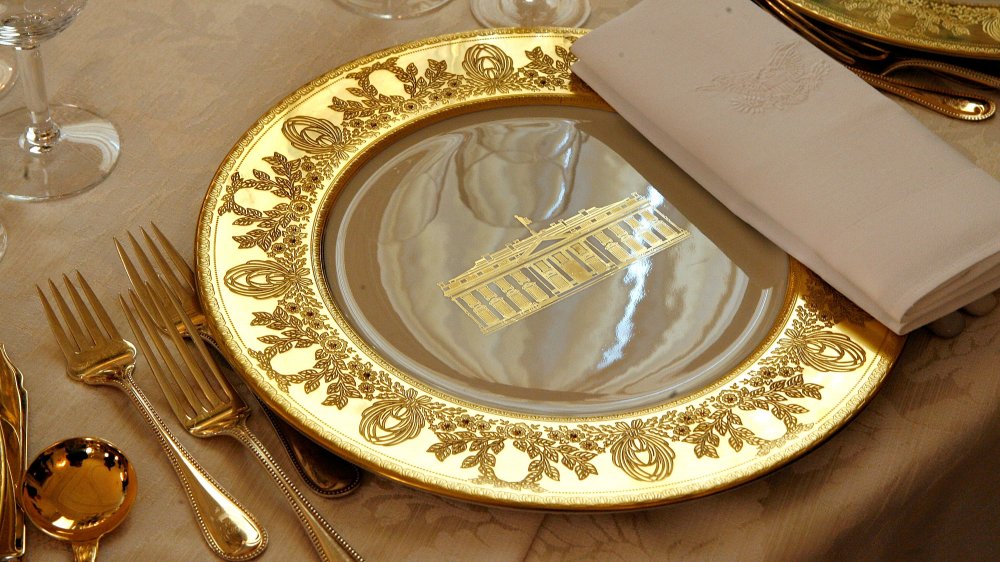Weird Rules That White House Chefs Have To Follow
A lot of workplaces have at least one weird rule that its employees have to follow. Californian Taco Bell workers can't buy discounted food on their lunch break and then go outside. In 2010, Australian Starbucks baristas weren't allowed to move from the expresso counter if that was their station. Heck, there's even a Reddit thread that asks the question, "What's the most ridiculous rule in your place of work?" And this post has over 28,000 comments.
Another workforce that has to put up with its employer's strange directives is the White House kitchen staff. But unfortunately for these folks, they have to endure a load of absurd guidelines. The chefs need to cater to the President's tummy, jump through security hoops, and occasionally follow fancy dinner etiquette. That's right, they have to tolerate more than two or three unusual rules like the rest of us. Who would have thought that an institution that was built in 1792 would be in any way archaic?
So, let's put on our history helmets and sprint headfirst into the weird orders that the White House chefs must follow. Just make sure that you're strap is done up. A couple of these facts could hurt your head.
All food has to be screened by White House chefs
Throughout the years, many people have said that the President has official food tasters that check that their chow is safe. The fact-checking site Snopes declared that the claim, "Food tasters work on behalf of U.S. presidents," is true. The explanation then goes onto outline a bunch of sources that report on this phenomenon. Yet, on the other hand, a former White House chef named Walter Scheib told the Washingtonian that this position doesn't exist. He said, "There is no presidential food taster."
While Scheib did say that the food tasters are fictitious, he also admitted that there are security systems in place that aim to protect the President's meals. "Nothing gets to the President that hasn't fallen under somebody's jurisdiction," commented Scheib. "If the President is just grabbing a pretzel randomly at the table, it's been screened."
It does make a lot of sense that every presidential food item gets evaluated. Nevertheless, it's also a little other-worldly. Just imagine a chef going into work and legally not being allowed to offer their boss some Tic-Tacs that they brought in from home.
The executive White House chef's job is in the hands of the First Lady
The White House executive chef is a kitchen staff member with an incredible number of responsibilities. Men's Journal stated, "The executive chef is in charge of feeding the president and First Family every day, catering to official guests at the White House — from Prime Ministers to the egg-rolling masses — as well as all private functions for the president and the First Lady."
A layperson might imagine that the White House chooses who gets this central gig. However, that's not the case. As Ms. Magazine reported that "It is the duty of the First Lady to appoint the White House executive chef."
The First Lady also has the power to fire an executive chef. In 2005, The Washington Post said, "Laura Bush fired the White House executive chef in February." The person who was let go was White House chef Walter Scheib. He told the New York Times in a phone interview that it was difficult to satisfy Bush's stylistic requirements.
It's not unthinkably strange that the First Lady hires the executive chef. After all, they'll probably be eating many a meal that they serve up. But it is wild that they can fire an employee at their discretion and at any time. If you were working in the White House, you'd probably want a little more job security.
The White House pastry chef has to make a gingerbread house every year
The White House doesn't just have an executive chef. Oh no, it also has a staff member who specializes in pastries. Susan Morrison, the current executive pastry chef, outlined her responsibilities to O, The Oprah Magazine back in 2016. She said, "Most of my day-to-day focus is on desserts for White House events. I could be creating miniature pastries for a reception on the State Floor or serving sweets for a luncheon in the West Wing. Our top priority, though, is always the first family."
Morrison has an additional responsibility that's slightly more bizarre in nature. She has to build an impressive gingerbread house. "I spend all year thinking about the White House gingerbread house, but we don't begin baking until November," Morrison said. "Then, for about four days after Thanksgiving, we work tirelessly to build the house before moving it to the State Dining Room, where more than 60,000 guests will cycle through."
And Morrison wasn't the only pastry chef who was required to make a sensational gingerbread house. The HuffPost claimed that a confectionary building is created every year. Mic even released an article called "From Nixon to Trump, a history of the White House gingerbread home." It appears that if a person wanted this dessert gig, then they'd have to follow the rules and bake up an annual sculpture.
The President can cancel specific foods from the White House chefs' repertoire
John Moeller, a former White House chef, wrote in his memoir that he served at the pleasure of the President. This means that if the President wants to ban a specific food from going into his mouth hole, then it will probably become banned.
This topic is discussed in a C-SPAN program that interviews former White House chefs. One of these ex-employees, Pierre Chambrin, states that George H. W. Bush didn't want broccoli or Brussels sprouts served to him. He remembers, "I served him some Brussels sprouts. And he told the butler, 'Tell Pierre never to serve that to me again.'" That being said, it's worth noting that Bush didn't ban broccoli from the White House, he just didn't want to eat it himself. "Mrs. Bush asks for broccoli sometimes," comments Chambrin.
While it makes sense that this etiquette exists, it's also a tad hilarious. Just imagine a restaurant patron finding a waiter, asking them to tell the head chef not to ever give them tomatoes for the next four years, and then expect the place to remember that request.
The White House chefs are on call 24/7
A White House chef can't mute their mobile (or couldn't unplug their landline, in the old days) as they gently drift off to sleep. Well, they can, but they may end up in trouble if their employer calls them to come in to cook. Yup, when the President's in the building, the kitchen staff are on standby. Pastry chef Bill Yosses told HuffPost, "In theory, we were working 24/7."
However, while the President could technically tell a chef to whip up a 2:00 a.m. dish, Yosses was never required to make such a meal. "I was there for eight years and that did not occur." He went onto say, "There could be a national emergency and the people involved have to get up at 3 a.m. and handle a crisis. The crises happened, but they weren't hungry."
Walter Scheib also stated that he wasn't frequently asked to cook food at unconventional hours. He informed VICE, "We really didn't do much of the midnight snack thing." It seems as if the presidents that Scheib and Yosses served never really abused this power. It's fortunate that these chefs weren't treated like emergency room service dispensers.
A state dinner has a bunch of full-on rules for White House chefs
White House state dinners sound like the fanciest of affairs. According to The White House Historical Association, they are put on to honor the head of a government or a reigning monarch. Business Insider noted that hundreds of people can attend a single event. They also appear to be one of the most stressful banquets that a chef could ever cook for.
In 2012, The Blade reported that some past and present White House chefs spoke at a panel hosted by the Association of Food Journalists. This discussion illuminated a few intense state dinner rules. The Blade wrote, "Second portions are never offered, but will be served if a guest requests them." Moreover, the article noted, "From the moment the first course is placed on the table to the moment the last course is served, no more than 55 minutes may elapse. And each course must absolutely be ready to be served at the proper time; no delays will be tolerated."
Not only are these requirements sweat-inducing, they're also oddly specific. For instance, why is it that the last course is required to be served in less than 55 minutes from the beginning of the meal? Why not an hour? Who in the world came up with that number? These directives seem hoity-toity and like they were made to make the chefs' lives more difficult.
Sometimes White House chefs have to cook gobs of hard-boiled eggs
Every Easter, the White House hosts its annual Egg Roll. And if you're wondering what this event entails, you're probably not alone. Luckily, a writer named Max Bonem decided to break this tradition down. In a Food & Wine article, he said, "The White House Egg Roll is an annual race where kids push eggs through the grass of the White House's lawn with long-handled spoons." This shindig can additionally feature a classic Easter egg hunt and a bundle of other activities.
The White House's event also features a mind-boggling number of hard-boiled eggs. Bonem stated, "Over 14,000 hard-boiled eggs are hand-dyed for use in the Egg Roll and the hunt." The White House kitchen staff are sometimes required to hard boil and dye a ton, it not all, of these eggs. In 1998, the Los Angeles Times reported that these folks colored 7,200 shells for the celebration. Furthermore, The Atlantic showcased some photos of the 2001 team preparing these items. In the first pic, the chef assistants are working while a tower of egg boxes looms in the background. In the second snap, two employees are lifting a slew of them.
It's a little uncanny that this facility is sometimes required to cook heaps of eggs that will hopefully never be eaten. Needless to say, most kitchen workers don't have to annually boil food for a children's lawn game.
White House chefs can be ordered to make unusual meals
When the White House kitchen is cooking for the President, the staff members are probably going to give their boss something he wants to eat. This means that if the President is craving a peculiar meal, then his staff should be finding a way to make it — even if it's something somewhat strange.
Back in 1969, the Reading Eagle reported that Richard Nixon liked eating cottage cheese that was covered in ketchup. The newspaper wrote, "Nixon talked about his dish during an appearance at the White House Conference on Food, Nutrition and Health. He says he feels he should eat cottage cheese for diet and health reasons, but doesn't like the taste. So he covers it with ketchup, which he does like."
In a C-SPAN interview, host Susan Stamberg asks the former White House chefs if they'd cook this meal for Nixon. She says, "I wonder how you would have reacted when day after day the request from him came, 'I'll have cottage cheese with ketchup.'" Frank Ruta, who'd worked in the kitchen for 11 years, shrugs his shoulders. It's as if he's expressing that he doesn't understand that flavor combination, but he'd still make it for the President. Unusual meals like this one highlight how atypical a White House kitchen job is. Not many restaurants would instruct a chef to make such a dish.
The executive White House chef receives no overtime pay
Being an executive chef at the White House is a lot of hard work. They're planning state dinners, they're potentially working strange hours, and they're cooking for the President. However, while these responsibilities seem rather demanding, this position receives no overtime pay whatsoever.
The New York Times laid out this fact in a story that they published in 2005. The newspaper said, "The pay, $80,000 to $100,000 a year with no overtime, for what is essentially a private family chef who occasionally has an opportunity to show off at a state dinner, is well below what top level chefs can earn on the outside."
It is truly baffling that White House executive chefs aren't allowed to obtain overtime payments. The fact that they could be asked to make up a plate at any time and would not be compensated if they did work extra hours makes their workplace sound astoundingly stingy.
A President can even direct their White House chefs to brew beer
If you were a White House chef, you'd probably think that your responsibilities would essentially be limited to cooking. But this assumption would be incorrect. For instance, the President could even ask you to make them some beer from scratch.
The first President to tell his kitchen staff to brew some beer was Barack Obama. His White House even released a 2012 video that explains why it was created. In this clip, assistant chef Sam Kass says, "Brewing beer is becoming a thing that Americans are doing in their homes and garages across the country. And the President certainly thought it would be a good idea to see if we could join the American people in that time-honored tradition and brew some of our own beer." This recording then goes on to outline how these beverages are created.
Even though the kitchen staff seems genuinely enthusiastic about making this product, it's a bit silly that Obama can direct them to create a brew. Beer isn't a meal, nor is it an item that chefs typically make.
The White House chefs need the highest level of security clearance
It goes without saying that The United States Secret Service doesn't want the President's food to be poisoned. Because that chain of events wouldn't be ideal. But it also appears as if this organization doesn't want to be a hawk in the White House kitchen. Therefore, in order to allow the President to eat, they give the chefs a special title that authorizes them to cook for the President.
Walter Scheib actually mentioned this to VICE: "The clearance that you have when you're working in the White House is called Top Secret Presidential Proximity." He also asserted, "Obviously, this is one of the most security-cleared posts you can get. In terms of the few of us that are in the kitchen who have that clearance, if you think about it, we're not just around outside and next to the President; we're physically inside of him. You really couldn't get any more close to that."
Not many chefs in the world can say that they need "Top Secret Presidential Proximity" clearance just to make a meal.
The White House kitchen staff can't comment on the executive chef hiring process
In 2005, The New York Times wrote another piece about the White House culinary world. It reported that the establishment's assistant chef Cristeta Comerford would potentially become their executive chef. However, while Comerford was up for this position, she couldn't comment on how her employer chooses the person they want for the job.
The publication stated, "The candidates have been asked to keep mum about the selection process, and they are aware that the wrong word may remove them from consideration ... As a White House employee, Ms. Comerford, 41, has refused to provide anything beyond the culinary world's equivalent of name, rank, and serial number. 'You know the rules of the house,' she said in a quiet but firm voice."
Since The New York Times published this story, Comerford became the executive chef. She has also conducted interviews with Vogue, CNN, and Asia Society discussing her various responsibilities. Considering that Comerford's been able to openly discuss some of her experiences in the White House kitchen, it's interesting that she wasn't allowed to comment on the selection process.












